|
||||||||||
|
|
||||||||||
|
||||||||||
|
|
||||||||||
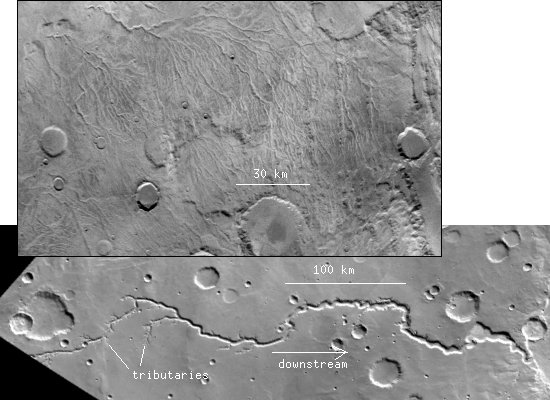
However, no liquid water remains on the surface of Mars today. The reason is clear given the planet's current atmospheric conditions. While Mars does have an atmosphere, it is very thin and only 1% as dense as that of Earth. The atmospheric pressure and temperature on the surface are so low that conditions are below the triple point of water. As illustrated below, the triple point defines the temperature and pressure above which water can be present in a liquid form.
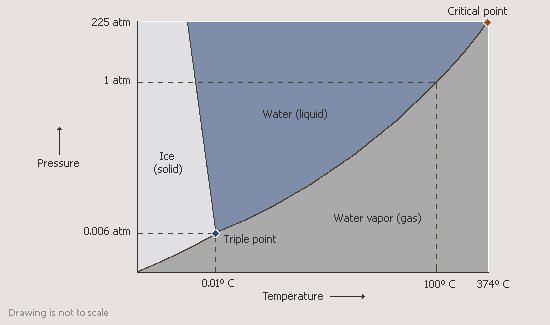
The Martian atmosphere today is so cold and thin that water can only exist in a solid state as ice or in a gaseous state as water vapor. Evidence of these forms of water on Mars can be seen in many photos returned by orbiters and landers that have visited the planet in recent years. The images below show the ice cap at the Martian north pole as well as wispy clouds of ice water high in the planet's atmosphere. Also pictured is a photo taken by one of NASA's Viking landers sent to Mars in 1976 showing frost on the ground.
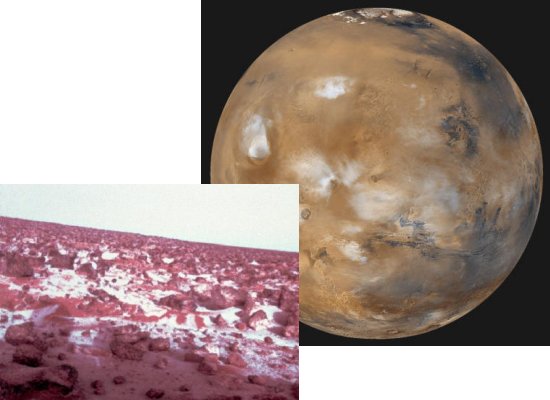
A more recent NASA probe was the Mars Odyssey orbiter sent in 2001 to conduct a detailed survey of the planet's surface and its composition. A global map generated by the spacecraft indicates the surface is rich in water ice, particularly near the poles where water typically makes up one-third to three-quarters of the soil.

Even regions closer to the equator contain a significant fraction of water averaging 5% to 10% by mass. These results suggest the Martian surface is largely permafrost similar to the tundra in regions like Siberia and northern Canada on Earth.

Since evidence suggests Mars was once much warmer and wetter than it is today, what happened to create the current climate of the planet? At some point in its history, Mars must have had a much thicker atmosphere than is present today. A thicker atmosphere would increase the surface pressure above the triple point so water could exist in a liquid form. The question then becomes what caused Mars to lose so much of its atmosphere?
Scientists are not yet sure what the answer to that question is, and this is one reason why they are so eager to continue exploring and studying Mars. However, the leading theory to explain this phenomenon is related to the magnetic field. Mars today appears to be a geologically dead world. There is no evidence of plate tectonics, volcanic activity, or other signs indicative of a hot interior deep beneath the surface.
Earth, on the other hand, has a very active interior made evident by volcanoes, earthquakes, and geothermal vents on its surface. These occurrences suggest the Earth has a high-temperature core keeping it geologically active. Earth's inner core is primarily solid iron surrounded by a more fluid outer core of molten iron. The two cores rotate at different rates, and perhaps even in opposite directions, to create the strong magnetic field surrounding our planet.

Mars has no magnetic field today, although magnetic signatures found in some of its rocks indicate the planet did possess such a field in the past. The scarcity of current geological activity combined with the lack of a magnetic field indicates the interior of Mars must have cooled to the point that its core no longer rotates. Without a protective magnetic field, Mars has no defense from the Sun's solar wind that bombards the planets of the solar system. Earth's magnetic field deflects these highly energetic particles around the planet and prevents them from directly impacting our atmosphere. Particles are instead trapped in the magnetic field and eventually do reach the atmosphere to create aurora. However, the magnetic field robs these particles of their high energy, and they can do no damage to Earth's environment.
Mars, on the other hand, has no protection from the barrage of high-speed charged particles that impact against it. This bombardment gives molecules within the Martian atmosphere sufficient energy to escape the planet's gravity and head into space. In other words, the solar wind has essentially "eroded" away the atmosphere of Mars over billions of years to create the thin atmosphere that exists today. As the atmosphere became thinner, it could no longer support liquid water and the climate dried up. Much of the water that once existed on Mars was probably converted to vapor as the atmosphere thinned and was then carried away from the planet by the solar wind. Scientists believe the water remaining on Mars today may represent only 10% of what existed billions of years ago.
These destructive forces remain at work on the Martian atmosphere even now. The European spacecraft Mars Express was launched to the planet in 2003 equipped with an instrument to measure the atmosphere. The orbiting probe compared the amount of solar wind particles entering the planet's atmosphere to the amount of gaseous particles leaving. Based on these measurements, it is estimated that Mars continues to lose nearly 100 tons of material from its atmosphere each day!
Both European and NASA probes to Mars have also studied its terrain and noticed significant differences between the rough, cratered highlands of the southern hemisphere and the smoother lowlands of the north. These observations suggest Mars may have once had a large ocean covering much of the northern hemisphere that reshaped its surface and eroded impact craters. Scientists have used detailed maps of the surface of Mars to create images of what the planet may have looked like approximately three and a half billion years ago when liquid water was plentiful.
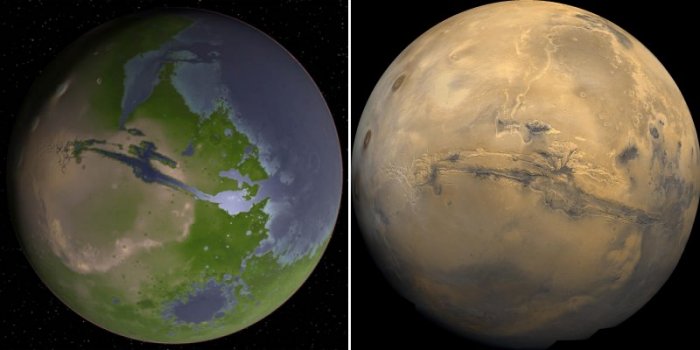
The search for water remains central to NASA's plans for future exploration of Mars. The rovers Spirit and Opportunity that landed on the planet in 2004 and continue to roam its surface were sent to regions where water may have existed. These two remarkably successful rovers have studied erosion patterns and surface geology discovering telltale clues that liquid water was once abundant in these areas.
NASA plans to continue sending orbiters, landers, or rovers to Mars every two years to focus on other areas of the planet where water is present. NASA is especially interested in the polar regions rich in ice. Other missions will search for aquifers deep underground where the temperature and pressure may be high enough for water to exist in liquid form. If so, it may be possible for simple life forms of some kind to survive much like they do on Earth in places like Antarctica.
NASA's next mission to the red planet is the Mars Reconnaissance Orbiter (MRO) due to launch in August 2005. This spacecraft carries very high-resolution cameras to perform a more detailed analysis of the surface than has ever been attempted before. MRO should reach Mars in March 2006 and will continue to search for evidence of water as well as for potential sites to land future missions. Other missions in development include a 2007 probe that will land near the north pole and a 2009 rover that will study the surface for at least one Martian year and evaluate its potential to support life. An ambitious plan being studied for the following decade is a sample return mission that will land on Mars, collect rocks and soil, and launch these materials back to Earth for analysis.
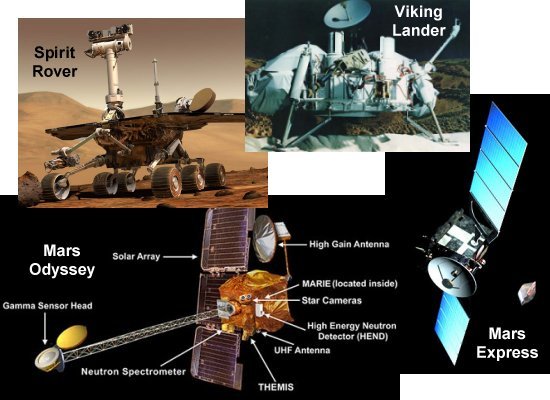
The overall goals of these missions range from the practical to the profound. Searching for the possible existence of life on another planet is certainly a worthy scientific endeavor, but it is not the only motivation for continued exploration of Mars. NASA hopes to eventually send humans to visit Mars and perhaps even establish a permanent base there one day. Exploiting the resources already present on Mars will make these missions more self-sufficient by using water for drinking and the growing of food. Water can also be split into hydrogen and oxygen for electricity, rocket fuel, and breathable air.
Perhaps even more important to this continued exploration of Mars is understanding how the planet changed from a
warm world covered with water into the cold and barren wasteland it is today. Answering these questions could
prove invaluable here on Earth where we may one day face the same changing climate that devastated the environment
of Mars so long ago.
- answer by Jeff Scott, 29 May 2005
Related Topics:
Read More Articles:


|
Aircraft | Design | Ask Us | Shop | Search |

|
|
| About Us | Contact Us | Copyright © 1997- | |||
|
|
|||